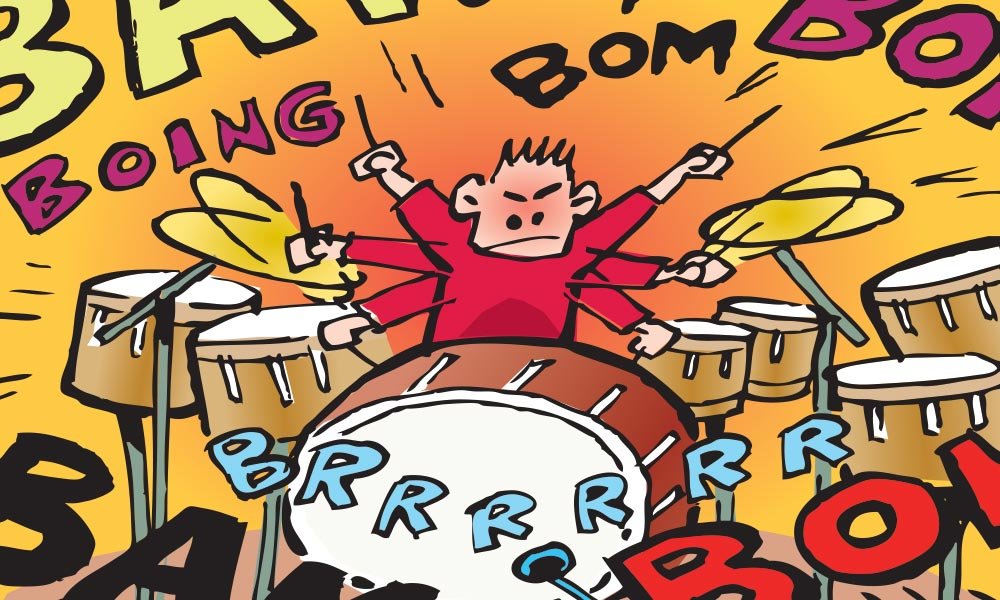The Single Stroke Four, which I prefer to call the Four Stroke Ruff, is one of the most lovely-sounding rhythmic embellishments played by drummers when executed perfectly, either with brushes or sticks. And it is used quite often by most players. But the ruff is not easy to perform exactly right every time. I’ve heard even top-notch drummers mess it up once in a while. The exercises below will go a long way in helping any
drummer develop or polish up this wonderful rudiment.
Read moreSo, I have an invention. I wanted to get a prototype made from my sketches and got a quote of $250 to have a one 3D printed. I thought that was pretty good and I was all set to commission the work. Then I got talking to a friend who is a designer and mentioned the prototype and the cost. He said he’d just bought a 3D printer for $300. Well that was enough to send me off in a totally different direction.
Read moreScott Johnson’s Drum Tuning Bible has been on the www for probably 25? years. I am publicizing this because it is an exhaustive resource and very useful to those who have questions about tuning drums. Johnson writes about every possible method of tuning, head choices and combinations, and dampening devices without bias toward any of them.
Read moreDeveloping the skill to play accents helps to strengthen your hands in order to build technique. Moreover, accents are an essential part of playing breaks and solos. Whether it’s rock, jazz, latin, marching or classical music, accents have an important role to play. The following etude is named , ACCENTUATION. It’s from my book, DUET YOURSELF BOOK TWO. The rhythmic makeup couldn’t be simpler since the etude is all with eighth notes. At first glance it’s deceptively easy, but working up the etude to speed without making mistakes might prove a little tricky for some readers.
Read moreI have a habit of ranting against the rudiments. Of course I'm referring to the classic rudiments of military origin. The point I usually try to press home is that many of the ‘standard’ rudiments are rather hard to apply to the drum set and others rarely fit modern music.
Read moreI'm a stickler for clean technique and a clean sound. I like to hear every stroke, every tap, every nuance, so I spend a lot of time on articulation to enhance my control and to refine my sound. And then someone like Stanton Moore comes along and raves about something he calls “the slop”. You can hear it in his playing, especially in his second line shuffle, where the strokes seem to just slosh around joyously. And boy does it cook!
Read moreJoel explains how the swing ride pattern is played differently at different tempos.
Read moreThe first book-length study of its kind, Drumsville! The Evolution of the New Orleans Beat is a companion to the New Orleans Jazz Museum exhibit that traces the history of drums and drumming in New Orleans from Native People to today. A main goal of Drumsville! is to provide the keys to understand how this legacy led to the creation of the drum set, an instrument so pervasive that few people question its origin
Read moreGreat podcast episode with Joel Rothman who, at 84, is still kickin’ and sharing his experiences as a life long drummer.
Read more…double-headed drums have regained their spot at the top of the food chain. But with more membranes comes more responsibly. Tuning a two-headed drum means tuning two heads and getting them to play nicely together.
Read moreI went to a sports medicine specialist, got X-Rayed and he pulls up
the picture, circles a spot in the middle of my hand and says “yep,
here’s your problem, you’ve got Osteoarthritis. See how the cartilage
is disappearing? And oh yeah, you’ve got a bone spur right here (adds
another circle). Happy day, Mr. Ray!”
Read moreJoel Rothman goes deep into time signatures and note values when explaining the jazz cymbal pattern.
Read moreWhen I was at music school, we had a coven of enthusiastic drummers, and almost every week one of our members would see some note-worthy drummer at a club and dutifully report the next day that the player had '4-way independence. But there's a problem with that assessment.
Read more* I heard a better one at a big band practice. The leader called out one of the trumpet players and said, “You're time's sort of all shot to hell”.
Read moreJoel Rothman, our newest columnist, explains the different rhythmic values of ruffs and drags.
Read moreWouldn't it be great if we could take a ‘speed listening’ course, one that would teach us to hear 'faster'? That way we’d be able to catch just about any turn in the road and respond immediately.
Read moreNot So Modern Drummer proudly welcomes new columnist and new advertiser, Joel Rothman. Joel is the author of almost 100 drum instruction books, most notably the best selling “Basic Drumming”, a very thick all-in-one method book for beginning and intermediate students. I started using this big red book in 1996 when I encountered it at Fork’s Drum Closet In Nashville where I taught for a number of years.
Read moreCymbals have an interesting history that dates back more than 3000 years. And it all begins with a chunk of yellow metal. Cymbals are made from alloy -- a blend of two (or more) metals. The alloy we’re all familiar with is what is traditionally called bell bronze, but there are other alloys to consider. So here is a quick guide to cymbal raw materials.
Read moreI posted an article some time ago on how to play quietly but there is another side to the equation. So let’s have a look at HOW TO PLAY LOUD.
Read more













